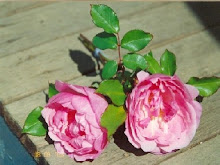this wide column features stories & photos et cetera in reverse order, with the most recent first (after this introduction).
I update the site a couple of times a week - themes are diverse from the practical to the aesthetic & the reflective; sharing questions, insights & a bit of whimsy.
Unless noted, the photos are mine, taken in the nursery garden. To enlarge thumbnails, left click on the image; then use your back button to return to the same page. Check it out on Minky Zammit, relaxing here after a day of smelling roses & other doglet pursuits.
 The right hand column contains information about the nursery & the roses; holds my post archives (both by month & 'Label' reference) and shows external links.
The right hand column contains information about the nursery & the roses; holds my post archives (both by month & 'Label' reference) and shows external links.I hope you enjoy this e-journal about the roses . . .


